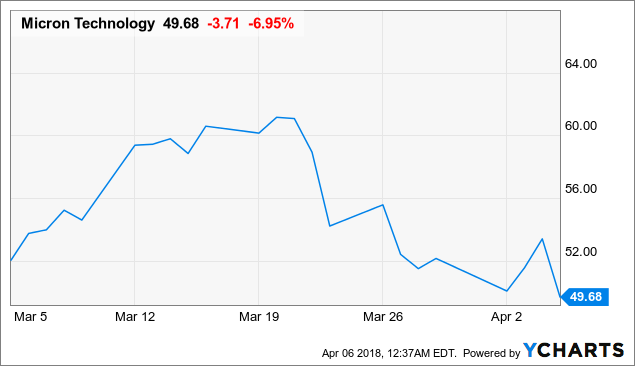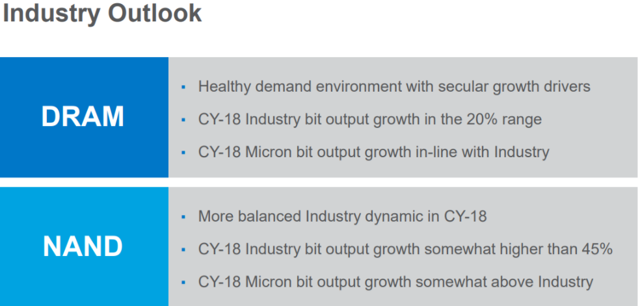I hope that everyone doesn't mind if I post MU related information on this board. Although I am long MU, I am always hesitant to assume that MU news is interesting to anybody else. That said, MU and WDC are competitors in the same industry and even though the companies have other businesses that do not compete with one another, the stock prices often move in sympathy to one another. The recent coverage of MU initiated by UBS is a perfect example. WDC got dragged down with MU even though UBS didn't say anything about WDC.
Here is a recent article about that coverage by UBS: seekingalpha.com
Micron: Ignore The Bears
Apr. 6.18 | About: Micron Technology (MU)

Gary Alexander
Software and cloud, high-growth technologies, IPOs
Summary
Micron has been unfairly pummeled by a bearish initiation from UBS and DRAM market concerns.
Micron has lost nearly 10% this week alone on overly negative sentiment.
Industry reports show that DRAM prices increased 5% in Q1, with further tightness expected throughout 2018.
Micron itself also recently upped its DRAM outlook for the year.
The company remains a bona fide value stock, trading under 5x forward earnings.
In a week of volatile market sentiment, the shorts have descended on Micron ( MU) yet again. After spending the first part of this year enjoying a tremendous rally that brought Micron over the $50 hurdle and finally moving it closer to a "normalized" valuation - though it's still far from being properly valued - Micron has lost momentum, with negative coverage weighing heavily on the stock.
Stealing the spotlight this week is a bearish initiation from UBS. Micron was one of a wave of semiconductor stocks to receive initiating coverage from the bank's new senior analyst, and it ended up receiving the short end of the stock, with the analyst pinning a $35 target and a Sell rating on Micron. Given that ~90% of Wall Street's ratings tend toward positive, if not neutral, the negative sentiment from a major investment bank carries some weight. Shares lost 7% on the news and carried further losses in after-hours trading, and are down about 20% from Micron's most recent peak:
 MU data by YCharts MU data by YCharts
But is there truly an argument for >30% downside (the implication of UBS's $35 price target) in a stock that's already so cheaply valued? The bearish commentary and ensuing backlash that UBS unleashed are based on a premise that the memory cycle will begin to expire in the back half of 2018, and that Micron will drastically cut estimates and miss expectations by wide margins.
Such concerns have been floating around Micron from the dawn of time - or at least, for the past two years, since Micron climbed out of the last memory "bear market" in 2016. For certain, being concerned around the cyclicality of the memory market is valid; in the last cycle, Micron's sales were cut into fractions and at ultralow gross margins, producing huge losses for the company (exactly the opposite of where the company is now, posting huge >20% gross margin increases and growing profits by 2-3x year over year).
But there's little data to support the premature conclusion that the boom times are over. The big sources, for now, are pointing to continued tightness in the DRAM market. I'm fine holding on to my Micron shares through the current pullback, and will even be watching for opportunities to add more. Let the bears have a quick moment in the spotlight, then the rally will resume.
Now we're worried about DRAM?You might recall that the current downtrend in Micron began late last month, when Micron posted a large beat to earnings but made a slight tweak to its guidance in the NAND business, which makes up one-third of its revenues (DRAM being the other two-thirds). Here's a look at Micron's latest memory outlook for the year, taken from last quarter's release:
Figure 1. Micron FY18 memory outlook

Source: Micron investor relations
Micron called for NAND industry output growth of "somewhat higher than 45%," which was a downgrade from prior language of "approaching 50%" growth. This sent Micron's famously paranoid investors running for the exits, causing Micron to lose 8% after the earnings announcement. But the bright spot in the quarter was DRAM, with Micron expecting to achieve in-line industry output growth versus a prior expectation of being below industry.
I had argued then that as DRAM was the lion's share of Micron's business, the positive overtones on the DRAM business should outweigh the slight downgrade in NAND expectations. UBS, however, clearly doesn't seem to think Micron's guidance will hold, which some recent data can perhaps refute.
DRAM fundamentals not showing any signs of weaknessDRAMeXchange - one of the leading research firms that track prices of different types of DRAM in the market - reported that DRAM prices increased by 5% in the first quarter of 2018 relative to the fourth quarter of 2017. With trends showing no signs of slowdown, DRAMeXchange has further predicted a 3% sequential gain in prices in the second quarter of 2018.
Back-to-back quarters of pricing increases certainly don't sound like a market that's about to tip over. Part of the problem with the UBS argument is that it's supply-focused, based on the premise that supply growth will swell out of control.
Supply growth has been expected in 2018 for quite some time. Micron itself, as shown in its guidance slide, is pointing to 20% industry bit output growth, and other observers have cited a range of as high as 30% output growth. We've known for quite some time that yields would improve this year and that production would ramp, but is this any cause to run for the hills?
Don't ignore the demand side of the equation. The whole reason that supply is kicking into higher gear is in response to a huge surge in demand from a wide variety of end users. Micron noted in its last earnings call that the DRAM business has benefited from an expanded set of customers - unlike in the past, where the PC market totally dominated DRAM demand. Now, PCs as well as datacenter servers, graphics cards for gaming, and cryptocurrency miners are eating up large volumes of DRAM.
Observers of the gaming industry, in particular, put out a lot of coverage and speculation on DRAM prices, given that prices on graphics cards keep rising. That segment of customers is also grudgingly accepting that prices will remain elevated for quite some time. A DRAMeXchange analyst also noted that demand for server DRAM in China will rise 20% y/y in Q2, a huge amount higher than the single-digit growth expected for the rest of the world.
Recall also that the DRAM market is largely dominated by a three-headed hydra of vendors: Micron has about 21% of the market, and SK Hynix ( OTC:HXSCF) and Samsung ( OTC:SSNLF) make up 29% and 45% of the market, respectively (together, that's only five points shy of 100%). It would be foolish thinking to assume that these three huge companies will suddenly engage in a price war and decimate their profits to zero.
Micron's valuation is extremely compellingAnd as always, it's important to note how low Micron's valuation is - not only against semiconductor or technology stocks but also against the whole market as well. Now trading under $50, and with analyst consensus EPS for the year at approximately $11, Micron trades at 4.6x forward P/E. This is the kind of earnings multiple typically given to a dying manufacturing stock, but Micron is posting huge earnings growth on the order of 2-3x each quarter.
 MU PE Ratio (Forward) data by YCharts MU PE Ratio (Forward) data by YCharts
Of course, we do keep in mind that Micron is a cyclical stock, and just like General Motors ( GM) or Ford ( F), it would be foolish to assume the heyday will last forever - the history just doesn't support that kind of perma-bullish conclusion. But nor is it prudent to simply assume that Micron will just fall off a cliff when the memory "supercycle" ends. It's more prudent, in my opinion, to take a balanced middle-of-the-road approach and assume that the industry can ease itself into a period of stabilizing prices, growing supply in a way that balances with the growth in demand.
Can we be certain that the outcome will be positive? No, of course not, but at under 5x forward P/E, I'd say the risk-reward profile is extremely compelling.
The bottom line on Micron: the recent selloff is induced by paranoia more than anything else. There are few data points to support a sudden crash in DRAM fundamentals; in fact, the most recent pricing trends suggest that DRAM prices will continue to see modest lift in 2018. Though downgrades and sensational headlines always win the day with heavily traded stocks like Micron, cooler heads and fundamental data-backed analysis will always prevail.
Disclosure: I am/we are long MU.
I wrote this article myself, and it expresses my own opinions. I am not receiving compensation for it (other than from Seeking Alpha). I have no business relationship with any company whose stock is mentioned in this article.
***************************************************************************************************************
UWG |








